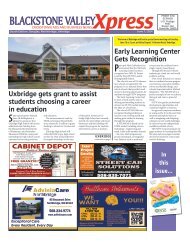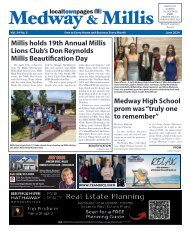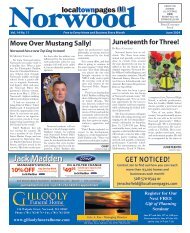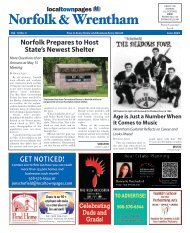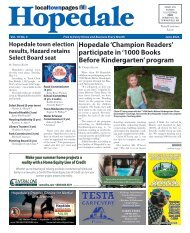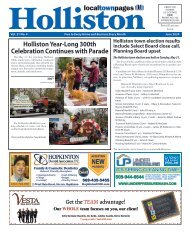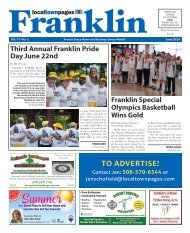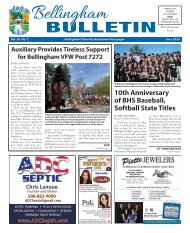Blackstone Valley August 25, 2023
Blackstone Valley August 25, 2023
Blackstone Valley August 25, 2023
Create successful ePaper yourself
Turn your PDF publications into a flip-book with our unique Google optimized e-Paper software.
30 The <strong>Blackstone</strong> <strong>Valley</strong> Xpress • www.theblackstonevalleyxpress.com • <strong>August</strong> <strong>25</strong>, <strong>2023</strong><br />
TALES FROM BEYOND <br />
tomdagostino.com<br />
Where are the remains of Rhode Island’s first settler?<br />
A mystery in two parts<br />
BY THOMAS D’AGOSTINO<br />
The title of this story poses<br />
an enigma in regard to the<br />
history of the Ocean State. So<br />
do the events that follow. If you<br />
visit Cumberland, Rhode Island,<br />
you will see a town rich with the<br />
history of industry and economic<br />
growth. Its mill houses and factory<br />
buildings that grace this<br />
parcel of land abound with stories<br />
and legends that are common to<br />
America’s youth. One portion of<br />
the town’s history is filled with a<br />
mystery that spans centuries.<br />
If you visit the village of Lonsdale,<br />
a section of Cumberland,<br />
take a trip to the Ann & Hope<br />
Mill Outlet. It was once the largest<br />
outlet store in the state as well as a<br />
monument of history in itself. Take<br />
a walk a little north of the parking<br />
lot and you will see a monument<br />
in a little square. This monument<br />
is the final resting place of<br />
Rhode Island’s first white settler,<br />
the Reverend William <strong>Blackstone</strong>,<br />
sometimes spelled Blaxton. There<br />
is one small problem, however, he<br />
is not resting there. Where is he<br />
then? Well, that is what we would<br />
all like to know. His story after<br />
his death is more interesting and<br />
mysterious than his achievements<br />
of being first founder of Rhode<br />
Island, alleged first founder of Boston,<br />
Massachusetts, and a minister<br />
of the Anglican Church.<br />
Reverend William <strong>Blackstone</strong><br />
settled in Shawmut, now Boston,<br />
in 1628. He became the solitary inhabitant<br />
after the rest of his fellow<br />
settlers left the area. But, it wasn’t<br />
long before he was sharing the<br />
real estate with the Puritans. Over<br />
the next couple of years, the two<br />
co-existed in somewhat harmony.<br />
Reverend <strong>Blackstone</strong> soon had<br />
his share of the Puritans and in<br />
1635 sold his land on what is now<br />
Beacon Hill and Charles Street.<br />
He then headed south towards<br />
present day Rhode Island. With<br />
his belongings, which included<br />
at one point, the largest library<br />
in New England, (it was one of<br />
the most extensive libraries of the<br />
new world), he settled in present<br />
day Cumberland. There he built<br />
a home removed from all other<br />
colonial influence and lived in his<br />
sought-after solitude of himself<br />
and his library. He called his home<br />
“Study Hill.” He is also credited<br />
with starting the first apple orchard<br />
in Rhode Island on his piece<br />
of real estate.<br />
Reverend <strong>Blackstone</strong> lived in<br />
peace among the local Indigenous<br />
Peoples as a self-imposed recluse<br />
until 1659 when he wed Sarah<br />
Stevenson of Boston. They had one<br />
son together named Johnathon.<br />
Sarah died in 1673 and the reverend<br />
would follow two years later in<br />
1675 at eighty years of age. He was<br />
buried near his home on Study<br />
Hill which was marked by two<br />
boulders abreast of a quartz stone<br />
marker. Shortly after, the King<br />
Philip’s War broke out among the<br />
colonists and Indians, and the very<br />
natives he lived in harmony with,<br />
burned his estate to the ground.<br />
It wasn’t until 1855 when the<br />
saga picks up again. It was then<br />
that a group of citizens gathered<br />
around the overgrown roughshod<br />
grave to pay tribute to their<br />
founder and raise money to have a<br />
proper, more modern monument<br />
planted in the place of the antiquated<br />
rock pile. Donations were<br />
taken but the monument never<br />
materialized. Neither did any<br />
refunds to the charity givers.<br />
Many years would pass as time<br />
took its toll and the weeds grew<br />
high hiding William <strong>Blackstone</strong>’s<br />
grave from common sight until<br />
The Lonsdale Company, owned<br />
by the firm of Brown and Ives,<br />
decided to expand their operations<br />
by building a mill on the <strong>Blackstone</strong><br />
River. This meant leveling<br />
Study Hill and moving Reverend<br />
<strong>Blackstone</strong>’s remains to another<br />
place.<br />
Luckily, a certain William<br />
Gammell was not only one of the<br />
directors of the Lonsdale Company,<br />
but the president of the Rhode<br />
Island Historical Society so when<br />
the Ann & Hope Mill was to take<br />
the place of Study Hill, it was he<br />
who saved the remains of William<br />
<strong>Blackstone</strong> from being totally dug<br />
up and lost. At least, for a while.<br />
A special meeting was held on<br />
July 26, 1886 where it is written<br />
that on May 6, 1886, respected<br />
Providence undertakers, Miles<br />
and Luther, exhumed the grave of<br />
William <strong>Blackstone</strong> only to find<br />
a few pieces of bone, some bone<br />
dust and the remaining nails from<br />
what once held together his long<br />
since deteriorated coffin. These<br />
artifacts were put in a special lead<br />
sealed box and were prepared for<br />
reburial. Witnesses to this historic<br />
act were Mr. Gammell and a descendant<br />
of the Reverend <strong>Blackstone</strong>,<br />
a Mr. Lorenzo <strong>Blackstone</strong>.<br />
Three years later the company<br />
decided it was going to erect a<br />
monument in honor of the great<br />
reverend. Yet at another meeting<br />
held on July 26, 1889, the descendants<br />
of Mr. <strong>Blackstone</strong> resolved<br />
to bear the expenses of erecting<br />
the monument that would relate<br />
the history, in their words, (as<br />
accurately as possible) the life and<br />
attributes of William <strong>Blackstone</strong>.<br />
The Lonsdale Company had no<br />
objections. Now is where things<br />
begin to get sketchy and plans go<br />
awry.<br />
The solution to the puzzle of the<br />
missing minister will be revealed in<br />
the next issue.<br />
It's Deck Time!<br />
NOW STOCKING<br />
Hardware<br />
Lawn and<br />
Garden Supplies<br />
Mon.-Fri. 7:30 a.m. - 5 p.m.<br />
Sat. 7:30 a.m. - Noon<br />
cslumberco.com<br />
Family Owned and Operated Since 1952<br />
• PROFESSIONAL SERVICE<br />
• FREE DELIVERY • ESTIMATING<br />
Count on us for all your building<br />
material needs<br />
124 Main Street,<br />
Millbury, MA<br />
(508) 865-4822





